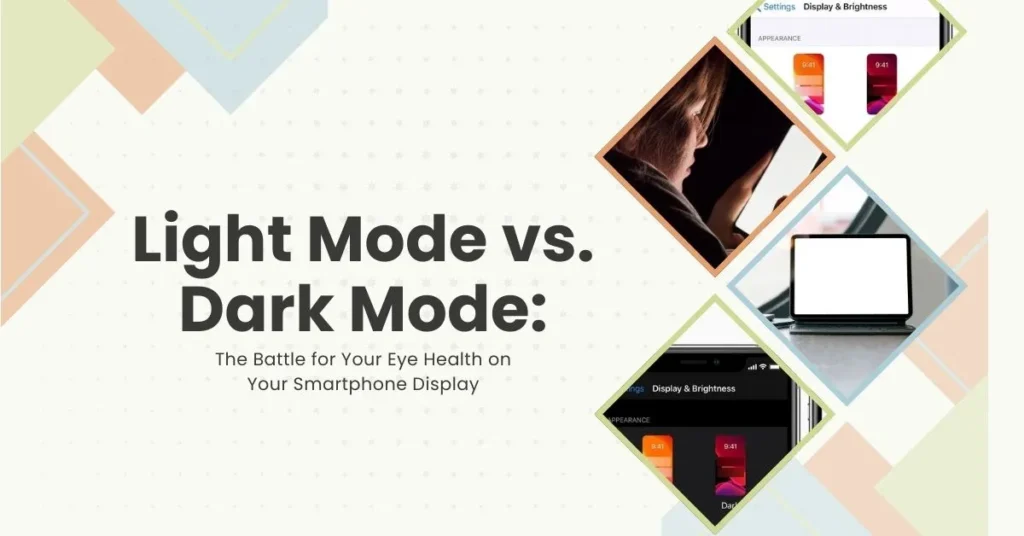Light Mode vs. Dark Mode: The Battle for Your Eye Health on Your Smartphone Display

In this age of constant connectivity, our smartphones have become digital lifelines. But as we spend countless hours staring at those illuminated displays, a question arises: Could the bright light they emit be silently harming our eye health? The debate between light mode and dark mode rages on, with proponents on each side. Let’s delve into the science and determine which mode is truly better for minimising digital eye strain and safeguarding our precious vision.
Unravelling Blue Light
At the heart of this debate lies blue light. This short-wavelength, high-energy light is found not only in sunlight but also emitted by our screens. While blue light itself is essential for regulating our sleep-wake cycle, excessive exposure, especially at night, presents potential problems:
- Digital Eye Strain: Prolonged blue light exposure can lead to tired, irritated, and dry eyes, headaches, and blurred vision – the classic symptoms of digital eye strain.
- Sleep Disruption: Blue light can trick your brain into thinking it’s daytime, suppressing melatonin, the sleep hormone. This makes it harder to fall asleep and impacts sleep quality.
- Long-Term Concerns: While more research is needed, some studies suggest a link between chronic blue light exposure and an increased risk of macular degeneration, a leading cause of blindness.
Light Mode: The Traditional Choice
Before the advent of dark mode, the default smartphone display was what we know as light mode – a bright background with contrasting dark text.
- Pros: Provides good visibility in bright environments, making it easier to read outside. It’s also the familiar format for most documents and websites.
- Cons: Emits a significant amount of blue light, contributing to digital eye strain, especially in low-light conditions.
Dark Mode: The Trendy Alternative
Dark mode inverts the colour scheme, featuring a dark background with lighter text. It’s increasingly popular for several reasons:
- Pros: Reduces eye strain in low-light settings by minimising screen glare. Emits less blue light, potentially making it easier to fall asleep after nighttime screen use. May improve battery life on certain devices.
- Cons: Can be harder to read in brightly lit environments. The inverted colours take some getting used to.

So, Who’s the Clear Winner?
Unfortunately, there’s no one-size-fits-all answer when it comes to light mode vs. dark mode. The best choice depends on multiple factors:
- Environment: Light mode generally works better in bright surroundings, while dark mode is superior for dimly lit spaces.
- Individual Preferences: Some people find dark mode less visually comfortable, making light mode a better choice for them.
- Eye Conditions: Certain eye conditions may make one mode more comfortable than the other.
The good news is you don’t have to choose just one! Most modern smartphones allow you to switch between modes manually or set them to change based on the time of day.
Maximising Eye Health in the Digital Age: Beyond Display Modes
While dark mode might offer some advantages, it’s crucial to remember that it’s not a sole solution for protecting your eye health from excessive screen time. Here are essential tips:
- The 20-20-20 Rule: Every 20 minutes, look at something 20 feet away for at least 20 seconds to give your eyes a break.
- Blink Often: Focus on screens can reduce your blink rate, leading to dry eyes. Consciously blink more!
- Adjust Brightness: Match your screen brightness to your surroundings. Avoid using full brightness in dark environments.
- Hold it Right: Keep your smartphone a comfortable distance from your eyes, about an arm’s length away.
- Blue Light Filters: Use your device’s built-in blue light filter or consider blue-light-blocking glasses.
- Regular Eye Exams: The best way to safeguard your eye health is by seeing an eye doctor for regular comprehensive exams.
Global Eye Hospital | Eye Care Consultation
The choice between light mode and dark mode on your smartphone display offers a chance to prioritise your eye health. While dark mode may mitigate blue light exposure and reduce digital eye strain in specific settings, it’s not a magical cure-all. Ultimately, the best mode is the one that minimises discomfort for you.
To promote optimal eye health, prioritise healthy smartphone habits and consult one of our optometrists at Global Eye Hospital for personalised advice. Remember, moderation and regular breaks are key, regardless of your preferred display mode! By being mindful of screen time and seeking professional eye care, you can safeguard your precious vision in this ever-connected world.
Book your appointment now for all eye-related services.
Your Vision Our Focus


